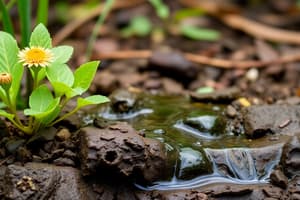Podcast
Questions and Answers
What characteristic of life describes an organism's ability to adjust to environmental changes?
What characteristic of life describes an organism's ability to adjust to environmental changes?
- Growth & Development
- Response to the environment (correct)
- Order
- Energy processing
Which characteristic of life entails the ability to maintain a stable internal environment?
Which characteristic of life entails the ability to maintain a stable internal environment?
- Regulation (correct)
- Reproduction
- Evolutionary adaptation
- Energy processing
What is the significance of the Three Domain classification system in biology?
What is the significance of the Three Domain classification system in biology?
- It eliminates the necessity of scientific naming.
- It offers a comprehensive understanding of evolutionary relationships among organisms. (correct)
- It is solely based on physical characteristics.
- It simplifies the study of individual species.
What process is described by the term 'evolutionary adaptation'?
What process is described by the term 'evolutionary adaptation'?
What does binomial nomenclature refer to in the context of taxonomy?
What does binomial nomenclature refer to in the context of taxonomy?
How does energy processing contribute to an organism's life functions?
How does energy processing contribute to an organism's life functions?
What is a key feature of growth and development in living organisms?
What is a key feature of growth and development in living organisms?
What does the property of 'order' refer to in living organisms?
What does the property of 'order' refer to in living organisms?
What defines biological evolution?
What defines biological evolution?
Which level of biological organization directly encompasses all organ systems working together?
Which level of biological organization directly encompasses all organ systems working together?
What is NOT a characteristic of natural selection?
What is NOT a characteristic of natural selection?
Which of the following represents the smallest unit of life that has the properties of life?
Which of the following represents the smallest unit of life that has the properties of life?
Which statement accurately describes the flow of genetic information in an organism?
Which statement accurately describes the flow of genetic information in an organism?
Which level of biological organization includes both living organisms and their physical environment?
Which level of biological organization includes both living organisms and their physical environment?
In an evolutionary tree, what does the concept of descent with modification imply?
In an evolutionary tree, what does the concept of descent with modification imply?
What best defines a community in an ecological context?
What best defines a community in an ecological context?
Which of the following is NOT a characteristic of prokaryotic cells?
Which of the following is NOT a characteristic of prokaryotic cells?
What does the classification rank of Kingdom represent in the hierarchy of life?
What does the classification rank of Kingdom represent in the hierarchy of life?
Which domain consists of organisms that thrive in extreme environments?
Which domain consists of organisms that thrive in extreme environments?
How is the genus name formatted when naming an organism?
How is the genus name formatted when naming an organism?
Which of the following kingdoms includes multicellular organisms?
Which of the following kingdoms includes multicellular organisms?
What is a common feature of organisms in Domain Bacteria?
What is a common feature of organisms in Domain Bacteria?
What type of cells comprise organisms in Domain Eukarya?
What type of cells comprise organisms in Domain Eukarya?
What is the smallest unit that retains the properties of an element?
What is the smallest unit that retains the properties of an element?
What is the primary role of hemoglobin in the body?
What is the primary role of hemoglobin in the body?
Which statement best illustrates the relationship between structure and function at the cellular level?
Which statement best illustrates the relationship between structure and function at the cellular level?
What type of organisms convert sunlight into chemical energy?
What type of organisms convert sunlight into chemical energy?
What happens to energy during the transfer and transformation in ecosystems?
What happens to energy during the transfer and transformation in ecosystems?
Which statement about decomposers is accurate?
Which statement about decomposers is accurate?
What is the focus of systems biology in analyzing biological systems?
What is the focus of systems biology in analyzing biological systems?
Which level of life demonstrates the relationship between structure and function through cellular shape?
Which level of life demonstrates the relationship between structure and function through cellular shape?
What role do omnivores play in the flow of energy in an ecosystem?
What role do omnivores play in the flow of energy in an ecosystem?
Flashcards are hidden until you start studying
Study Notes
Introduction to Biology
- Biology is the scientific study of life, focusing on the characteristics that define living organisms.
- Key properties of life include order, reproduction, growth and development, response to the environment, energy processing, regulation, and evolutionary adaptation.
Properties of Life
- Order: Organisms possess highly ordered structures, from basic cells to complex ecosystems.
- Reproduction: The ability to produce offspring that resemble the parent.
- Growth & Development: Growth patterns and development are dictated by inherited DNA.
- Response to the Environment: Organisms react to environmental stimuli.
- Energy Processing: Chemical energy powers activities and biochemical reactions within organisms.
- Regulation: Homeostasis allows organisms to maintain internal environments conducive to life.
- Evolutionary Adaptation: Populations evolve adaptations over generations, enhancing their survival and reproduction.
Diversity of Life
- Biological diversity is a core principle of life, classified into categories based on taxonomy.
- Taxonomy organizes life into domains and uses binomial nomenclature for scientific naming, such as Homo sapiens for humans.
- In nomenclature, the genus name is capitalized, and the entire name is italicized.
The Three Domains of Life
- Domain Bacteria: Consists of diverse, abundant prokaryotic organisms; crucial for health, disease, and environmental cleanup.
- Domain Archaea: Prokaryotic organisms thriving in extreme environments, including halophiles (salt-loving), thermophiles (heat-loving), and methanogens (anaerobic).
- Domain Eukarya: Eukaryotic organisms categorized into four kingdoms:
- Kingdom Protista: Unicellular organisms.
- Kingdom Plantae: Multicellular plants.
- Kingdom Fungi: Multicellular fungi.
- Kingdom Animalia: Multicellular animals.
Hierarchy of Life
- Life's organization ranges from microscopic units to vast ecosystems:
- Atoms: Basic units of matter.
- Molecules: Combinations of atoms.
- Organelles: Structures within cells that perform functions.
- Cells: Fundamental units of life where life properties emerge.
- Tissues: Groups of similar cells performing a function.
- Organs: Structures composed of different tissues working together.
- Organ Systems: Groups of organs coordinating functions.
- Organisms: Complete living beings composed of functioning organ systems.
- Populations: Groups of the same species interacting in a shared area.
- Communities: Interactions among different populations.
- Ecosystems: Communities plus physical environment.
- Landscapes: Connected ecosystems.
- Biosphere: The global sum of all ecosystems.
Unifying Themes of Biology
- Evolution: A gradual process of change over time, with natural selection as its driving mechanism.
- Populations, not individuals, evolve, responding to environmental pressures over generations.
- Flow of Information: Genetic information encoded in DNA directs structure and function.
- Gene expression: DNA transcribed into RNA, which is translated into proteins that perform various cellular functions.
Structure & Function
- The correlation between structure and function is essential at all biological levels:
- Molecular level: Protein structure relates to its function (e.g., hemoglobin's oxygen transport).
- Cellular level: Cell shape impacts its function (e.g., neurons transmitting impulses).
Transfer and Transformation of Matter and Energy
- Energy flows directionally through ecosystems; sunlight is converted by producers into chemical energy.
- Producers (photoautotrophs): Convert sunlight into chemical energy (e.g., through photosynthesis).
- Consumers (heterotrophs): Organisms consume organic matter and convert it into energy via cellular respiration.
- Decomposers: Break down organic material, recycling energy and nutrients.
- Energy transformation results in inevitable loss, primarily as heat.
Interactions within Systems
- Systems biology analyzes interactions among biological parts to understand complex life systems, illustrating interconnectivity across biological scales.
Studying That Suits You
Use AI to generate personalized quizzes and flashcards to suit your learning preferences.




